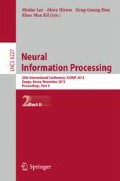Abstract
This paper studies a simple digital dynamical system that can generate various spike-trains. In order to consider the steady and transient states, we use two basic feature quantities. The first one is the number of co-existing periodic spike-trains that can characterize richness of the steady state. The second one is the concentricity of transition to the periodic spike-trains that can characterize variation of transient phenomena. Performing numerical experiments for two typical examples based on the bifurcating neuron, basic classification of the dynamics is considered.
Access this chapter
Tax calculation will be finalised at checkout
Purchases are for personal use only
Preview
Unable to display preview. Download preview PDF.
References
Horimoto, N., Saito, T.: Analysis of Digital Spike Maps based on Bifurcating Neurons. NOLTA, IEICE, E95-N 10, 596–605 (2012)
Ogawa, T., Saito, T.: Self-organizing Digital Spike Interval Maps. In: Lu, B.-L., Zhang, L., Kwok, J. (eds.) ICONIP 2011, Part II. LNCS, vol. 7063, pp. 612–617. Springer, Heidelberg (2011)
Chua, L. O.: A nonlinear dynamics perspective of Wolfram’s new kind of science, I, II. World Scientific (2005)
Wada, W., Kuroiwa, J., Nara, S.: Completely reproducible description of digital sound data with cellular automata. Physics Letters A 306, 110-115 (2002)
Ito, R., Nakayama, Y., Saito, T.: Learning of Dynamic BNN toward Storing-and-Stabilizing Periodic Patterns. In: Lu, B.-L., Zhang, L., Kwok, J. (eds.) ICONIP 2011, Part II. LNCS, vol. 7063, pp. 606–611. Springer, Heidelberg (2011)
Ott, E.: Chaos in dynamical systems. Cambridge (1993)
Campbell, S.R., Wang, D., Jayaprakash, C.: Synchrony and desynchrony in integrate-and-fire oscillators. Neural Computation 11, 1595–1619 (1999)
Izhikevich, E.M.: Simple Model of Spiking Neurons. IEEE Trans. Neural Networks 14(6), 1569–1572 (2003)
Torikai, H., Funew, A., Saito, T.: Digital spiking neuron and its learning for approximation of various spike-trains. Neural Networks 21, 140–149 (2008)
Torikai, H., Nishigami, T.: An artificial chaotic spiking neuron inspired by spiral ganglion cell: parallel spike encoding, theoretical analysis, and electronic circuit implementation. Neural Networks 22, 664–673 (2009)
Rulkov, N.F., Sushchik, M.M., Tsimring, L.S., Volkovskii, A.R.: Digital communication using chaotic-pulse-position modulation. IEEE Trans. Circuits Systs., 48(12), 1436–1444 (2001)
Iguchi, T., Hirata, A., Torikai, H.: Theoretical and heuristic synthesis of digital spiking neurons for spike-pattern-division multiplexing. IEICE Trans. Fundamentals, E93-A 8, 1486–1496 (2010)
Matsubara, T., Torikai, H.: Asynchronous cellular automaton-based neuron: theoretical analysis and on-FPGA learning. IEEE Trans. Neiral Netw. Learning Systs. 24, 736–748 (2013)
Amari, S.: A Method of Statistical Neurodynamics. Kybernetik 14, 201–215 (1974)
Perez, R., Glass, L.: Bistability, period doubling bifurcations and chaos in a periodically forced oscillator. Phys. Lett., 90A 9, 441–443 (1982)
Torikai, H., Saito, T., Schwarz, W.: Synchronization via multiplex pulse-train. IEEE Trans. Circuits Syst. I 46(9), 1072–1085 (1999)
Author information
Authors and Affiliations
Editor information
Editors and Affiliations
Rights and permissions
Copyright information
© 2013 Springer-Verlag Berlin Heidelberg
About this paper
Cite this paper
Horimoto, N., Saito, T. (2013). Digital Dynamical Systems of Spike-Trains. In: Lee, M., Hirose, A., Hou, ZG., Kil, R.M. (eds) Neural Information Processing. ICONIP 2013. Lecture Notes in Computer Science, vol 8227. Springer, Berlin, Heidelberg. https://doi.org/10.1007/978-3-642-42042-9_24
Download citation
DOI: https://doi.org/10.1007/978-3-642-42042-9_24
Publisher Name: Springer, Berlin, Heidelberg
Print ISBN: 978-3-642-42041-2
Online ISBN: 978-3-642-42042-9
eBook Packages: Computer ScienceComputer Science (R0)

